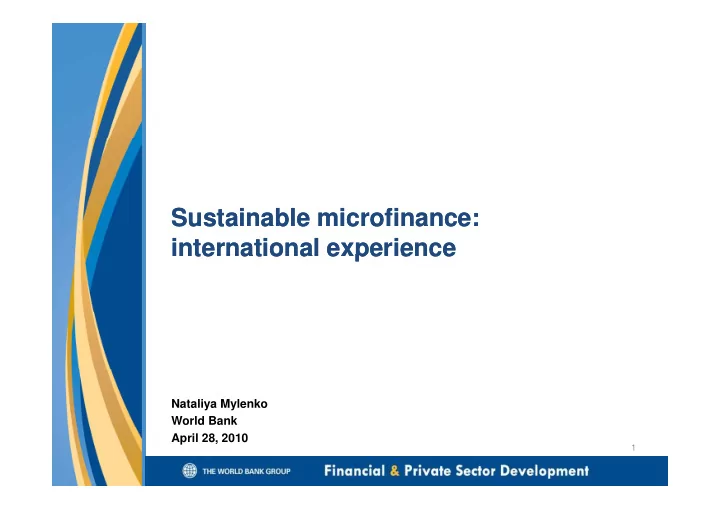

Sustainable microfinance: Sustainable microfinance: international experience international experience international experience international experience Nataliya Mylenko World Bank April 28, 2010 1
2.7 billion people (70% of adult population) in emerging markets do not have access to basic financial services such as savings or checking account 2 Source: Financial Access 2010, World Bank Group
Microfinance emerged as a possible solution for financing needs for micro entrepreneurs and low income individuals for micro entrepreneurs and low income individuals The first Microcredit Summit, gathered more than 2,900 people from 137 and launched a nine-year campaign to reach 100 from 137 and launched a nine year campaign to reach 100 million of the world’s poorest families, by the year 2005. The goal is nearly reached by 2005. The United Nations designates International Year of Microcredit, adopting the goal of building inclusive financial systems. Microcredit Summit campaign re-launched, with a goal for 2015 of reaching 175 million of the world’s poorest families by 2015, g p y and ensuring that 100 million families rise above the US$1 a day threshold. G-20 countries commit to improving access to financial services for G-20 countries commit to improving access to financial services for the poor. “Agree to support the safe and sound spread of new modes of financial service delivery capable of reaching the poor and, building on the example of micro finance, will scale up the successful models of small and medium-sized enterprise financing.” p g 3
Over the years microfinance evolved and now represents a significant portion of financial systems in terms of the number of clients in many portion of financial systems in terms of the number of clients in many countries Microcredit i di Microfinance ‐ Providing only loans - Providing savings, for micro ‐ payments, insurance entrepreneurs t services in addition to i i dditi t ‐ Granting small loans loans to solidarity (or joint - Individual and group lending lending liability groups) liability groups) ‐ Mostly provided by - Provided by financially sustainable financial NGOs and donor ‐ institutions funded initiatives funded initiatives 4
Challenge: how to provide access to a full range of financial services to the poor in a cost effective and sustainable manner? Cost of processing a large number of small loans is high especially for low income Cost of processing a large number of small loans is high, especially for low income and microenterprises due to: 1) Lack of collateral 1) Lack of collateral 2) Lack of documentation including financial records 3) Low levels of financial literacy of the potential clients 4) Geographical dispersion of clients 4) Geographical dispersion of clients 5
Addressing the financing component: Possible models for providing microfinance – operational side Delivery of microfinance in a sustainable manner requires the development of qualified financial service providers. 1) Commercial bank down-scaling – development of MSME banking 1) Commercial bank down-scaling – development of MSME banking skills and products leveraging strengths of existing operations of the commercial bank 2) Transformation of microfinance institution – transition from NGO or donor-funded initiatives to professionally managed provision or donor funded initiatives to professionally managed provision of a broad range of financial services 3) Community financial institutions – by building linkages with ) C f banks to ensure scale and sustainability 6
Regulatory environment for microfinance needs to balance incentives for expanding access and maintaining soundness of financial for expanding access and maintaining soundness of financial institutions 1) Clearly identifying and separating out subsidy element in microfinance operations microfinance operations 2) Sustainable institutions need to diversify risks, and thus be able to provide a broad range of services (and often operate across a p g ( p number of market segments) 3) Credit may not be the most suitable financial product for the poor (consider welfare) ( id lf ) 4) Create regulatory incentives for existing financial institutions to provide financial services to the low income segment beyond provide financial services to the low income segment, beyond corporate and social responsibility 7
Challenge – in the absence of clear indicators of social performance, measuring performance of double bottom line institutions is limited to financial performance – reducing incentives for financiers to support microenterprises Financial Financial objectives: outreach and ? ? performance of a fi financial i l institution Measured on a regular Measured on a regular basis, clear definitions and basis, clear definitions and Impact of f standards in place standards in place microfinance Social objectives: improved income of the ? ? income of the client, improved No clear standard, only No clear standard, only social outcomes a few institutions a few institutions measure, on ad hoc measure, on ad hoc basis basis 8
Social Performance Principles – developed through social performance task force (SPTF) • Translate MFI’s mission and values into clear, measurable objectives to capture intentional social benefits objectives to capture intentional social benefits. 1 1 • Design and implement systems for social responsibility, including client protection. 2 • Track, understand and report on whether MFI is achieving • Track understand and report on whether MFI is achieving its social objectives. 3 • Align its business processes to achieve both social and financial objectives. 4 • Ensure that decision ‐ making considers both social and financial outcomes. 5
Conclusions Conclusions � Mi Microfinance emerged as a possible solution for financing fi d ibl l ti f fi i needs for micro entrepreneurs and low income individuals � Sustainable business model requires introduction of the Sustainable business model requires introduction of the right products � Delivery of microfinance in a sustainable manner requires the development of qualified financial service providers and linkages with available distribution channels for financial services � Effective measurement and evaluation framework for donors and development agencies is important to put in place correct incentives t i ti 10
Thank you! Nataliya Mylenko Financial and Private Sector Development p East Asia and Pacific Region, The World Bank Group 1818 H Street, N.W., Washington, DC 20433 nmylenko@worldbank.org l k @ ldb k 11
Recommend
More recommend